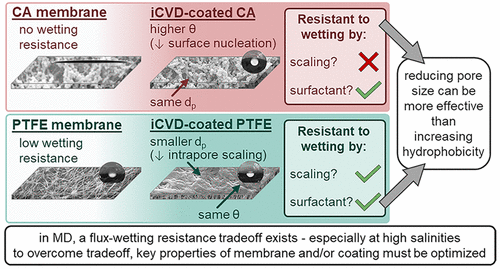当前位置:
X-MOL 学术
›
ACS Appl. Polym. Mater.
›
论文详情
Our official English website, www.x-mol.net, welcomes your feedback! (Note: you will need to create a separate account there.)
Hydrophobicity versus Pore Size: Polymer Coatings to Improve Membrane Wetting Resistance for Membrane Distillation
ACS Applied Polymer Materials ( IF 5 ) Pub Date : 2020-03-04 , DOI: 10.1021/acsapm.9b01133 Allyson L. McGaughey 1 , Prathamesh Karandikar 2 , Malancha Gupta 2 , Amy E. Childress 1
ACS Applied Polymer Materials ( IF 5 ) Pub Date : 2020-03-04 , DOI: 10.1021/acsapm.9b01133 Allyson L. McGaughey 1 , Prathamesh Karandikar 2 , Malancha Gupta 2 , Amy E. Childress 1
Affiliation

|
Initiated chemical vapor deposition (iCVD) was used to coat two porous substrates (hydrophilic cellulose acetate (CA) and hydrophobic polytetrafluoroethylene (PTFE)) with a cross-linked fluoropolymer to improve membrane wetting resistance. The coated CA membrane was superhydrophobic and symmetric. The coated PTFE membrane was hydrophobic and asymmetric, with smaller pore size and lower porosity on the top surface than on the bottom surface. Membrane performance was tested in membrane distillation experiments with (1) a high-salinity feed solution and (2) a surfactant-containing feed solution. In both cases, the coated membranes had higher wetting resistance than the uncoated membranes. Notably, wetting resistances were better predicted by LEP distributions than by minimum LEP values. When LEP distributions were skewed toward high LEP values (i.e., when small pores with high LEP were greater in number), significant (measurable) salt passage did not occur. For the high-salinity feed solution, the coated PTFE membrane had greater wetting resistance than the coated CA membrane; thus, reduced surface pore size/porosity (which may reduce intrapore scaling) was more effective than increased surface hydrophobicity (which may reduce surface nucleation) in preventing scaling-induced wetting. Reduced pore size/porosity was equally as effective as increased hydrophobicity in resisting surfactant-induced wetting. However, reduced porosity can negatively impact water flux; this represents a permeability/wetting resistance trade-off in membrane distillation—especially for high-salinity applications. Membrane and/or membrane coating properties must be optimized to overcome this permeability/wetting resistance trade-off and make MD viable for the treatment of challenging streams. Then, increasing hydrophobicity may not be necessary to impart high wetting resistance to porous membranes. These results are important for future membrane design, especially as manufacturers seek to replace perfluorinated materials with environmentally friendly alternatives.
中文翻译:

疏水性与孔径的关系:改善膜蒸馏的膜润湿性的聚合物涂层
引发化学气相沉积(iCVD)用于用交联的含氟聚合物涂布两个多孔基材(亲水性醋酸纤维素(CA)和疏水性聚四氟乙烯(PTFE)),以提高膜的抗湿性。涂覆的CA膜是超疏水的并且是对称的。涂覆的PTFE膜是疏水的和不对称的,其顶表面的孔径小于底表面的孔径,并且孔隙率较低。在膜蒸馏实验中用(1)高盐度进料溶液和(2)含表面活性剂的进料溶液测试膜性能。在两种情况下,涂覆的膜均比未涂覆的膜具有更高的抗湿性。值得注意的是,与最小LEP值相比,通过LEP分布可以更好地预测耐湿性。当LEP分布偏向高LEP值(即,当具有高LEP的小毛孔数量更多时,则不会发生显着(可测量)的盐通过。对于高盐度进料溶液,涂覆的PTFE膜比涂覆的CA膜具有更高的抗湿性。因此,在防止结垢引起的润湿方面,减小的表面孔径/孔隙率(可能会减少孔内结垢)比增加表面疏水性(可能会减少表面成核作用)更有效。在抵抗表面活性剂诱导的润湿方面,减小的孔径/孔隙率与增加疏水性同样有效。但是,降低的孔隙度会对水通量产生负面影响;这代表了膜蒸馏中的渗透性/抗湿性折衷,特别是在高盐度应用中。必须优化膜和/或膜的涂层性能,以克服这种渗透性/抗湿性的折衷,并使MD在处理具有挑战性的料流方面可行。然后,可能不需要增加疏水性以赋予多孔膜高的抗湿性。这些结果对于未来的膜设计非常重要,尤其是在制造商寻求用环保的替代品替代全氟化材料时。
更新日期:2020-03-04
中文翻译:

疏水性与孔径的关系:改善膜蒸馏的膜润湿性的聚合物涂层
引发化学气相沉积(iCVD)用于用交联的含氟聚合物涂布两个多孔基材(亲水性醋酸纤维素(CA)和疏水性聚四氟乙烯(PTFE)),以提高膜的抗湿性。涂覆的CA膜是超疏水的并且是对称的。涂覆的PTFE膜是疏水的和不对称的,其顶表面的孔径小于底表面的孔径,并且孔隙率较低。在膜蒸馏实验中用(1)高盐度进料溶液和(2)含表面活性剂的进料溶液测试膜性能。在两种情况下,涂覆的膜均比未涂覆的膜具有更高的抗湿性。值得注意的是,与最小LEP值相比,通过LEP分布可以更好地预测耐湿性。当LEP分布偏向高LEP值(即,当具有高LEP的小毛孔数量更多时,则不会发生显着(可测量)的盐通过。对于高盐度进料溶液,涂覆的PTFE膜比涂覆的CA膜具有更高的抗湿性。因此,在防止结垢引起的润湿方面,减小的表面孔径/孔隙率(可能会减少孔内结垢)比增加表面疏水性(可能会减少表面成核作用)更有效。在抵抗表面活性剂诱导的润湿方面,减小的孔径/孔隙率与增加疏水性同样有效。但是,降低的孔隙度会对水通量产生负面影响;这代表了膜蒸馏中的渗透性/抗湿性折衷,特别是在高盐度应用中。必须优化膜和/或膜的涂层性能,以克服这种渗透性/抗湿性的折衷,并使MD在处理具有挑战性的料流方面可行。然后,可能不需要增加疏水性以赋予多孔膜高的抗湿性。这些结果对于未来的膜设计非常重要,尤其是在制造商寻求用环保的替代品替代全氟化材料时。



























 京公网安备 11010802027423号
京公网安备 11010802027423号